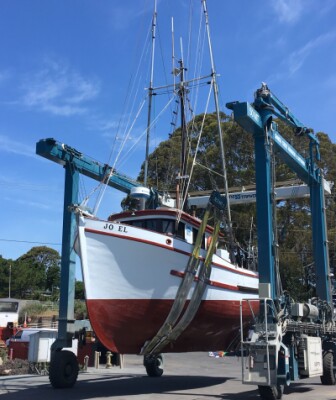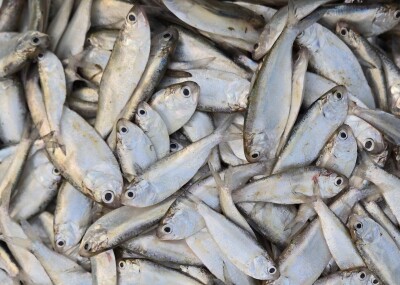Northeast
Fancy lobster boat will travel; less horsepower makes sense
Boatbuilding has slowed down at some New England boatyards, but not at Wesmac in Surry, Maine. Fishermen — commercial and sport — and recreational boat owners like the Wesmac hull with its hard chine V-bottom and full-keel design.
Wesmac is busy enough that it's hard to nail down the boatyard's Steve Wessel long enough to get a good idea of what the yard is doing. "Let me think what I've got going here. I'm so busy I'm on overload," he says as he searches for a file on a boat launched in October.
"She's for David Piper Jr. He's from Massachusetts. Plymouth is where he keeps her moored," Wessel says, as he pulls out information on Piper's 46-foot lobster boat.
Wessel calls Piper's boat, Old Glory, a "fancy lobster boat" because it has full live-aboard accommodations. Piper wanted that arrangement since he will be fishing for lobsters through the summer and fall, and then he will be taking the boat south to winter over in Florida.
"There's a complete galley, two air conditioners, two TV sets, a head, shower and bunks," Wessel says. To accommodate a lot of this stuff, the cabin area of the split wheelhouse is extended farther aft than normal.
For lobstering, there's a 14-inch hauler with a rope locker along the side to gather the line as it comes aboard from Piper's 7-trap trawls. Stainless steel sheathing is on the hauling side to protect the hull from the traps as they are hauled out of the water. Beneath the deck is a lobster tank that holds 400 pounds.
"This boat's loaded on the inside for pleasure use and has all the fishing stuff. It's the best of both worlds," Wessel says.
The Old Glory is cored on the sides but not on the bottom of the hull. The deck, wheelhouse and trunk cabin are cored as well, with Airlite foam.
All the composite panels for the deck, cabin and wheelhouse are vacuum bagged. Wesmac has been using this type of composite construction since the late 1980s, Wessel says.
The boat doesn't have the traditional deck-beam construction under the deck. Instead the deck is supported by panels running fore and aft and athwartship.
For power the Old Glory has an 850-hp Caterpillar C15, as well as a generator to run the electronics and air conditioning units.
Wessel says Wesmac has sent some boats to the West Coast, and is just starting another one. It is a 46-footer going to a commercial fisherman in Portland, Ore.
The boat will be rigged like a New England lobster boat "with a trap hauler and the whole works, but it will actually be used as a purse seiner," Wessel says.
In early November, Wesmac was building six sportfishing boats, and Wessel was talking to a customer about building a 46-footer for commercial fishing.
A little over two hours by road to the south of Surry is Lash Brothers Boat Yard in Waldoboro, where a 38-foot Calvin Beal hull is being finished off for Ryan Benner, a local lobsterman.
Benner's boat is pretty much a straight lobster boat with a solid fiberglass hull, molded top and a split wheelhouse.
Up forward is a V-berth area for storage, and under the plywood and fiberglass deck is a storage tank, says the boatyard's Wes Lash.
The boatyard's crew has also been doing some repair work to fishing boats and repowered a lobster boat. The repowering was unusual — though it may be a sign of things to come — in that the new engine has less horsepower than the old engine.
A 375-hp John Deere was hauled out of the lobster boat and a 275-hp John Deere went in. "It was because of fuel and the price of the engine — all a combination of our times. More might think about it if they could. As need be, I think they will," says Lash.
For the two fiberglass lobster boats that were hauled out for repair work, it was a case of, as Lash says, "A couple of rocks jumped out in front of them." Both boats were fairly simple repair jobs, requiring the damaged areas to be cut out of the keels and then patched back up. — Michael Crowley
West
Crab boat is being converted; Alaska yard has new gillnetter
There is something to be said for having an anchor watch — at least the owner of a 32-foot aluminum gillnetter that's getting his tophouse rebuilt at Edling Enterprises in Bellingham, Wash., probably thinks so.
The boat was anchored up when an errant salmon tender got much too close, caving in the gillnetter's bulwarks, anchor chock and roller before sliding off. "Then it kind of crushed the port side of the flying bridge," says Edling Enterprises' John Edling.
Edling Enterprises had "finished the boat here a couple of years ago. We had bolted the flybridge on, so we just unbolted it," says Edling.
The third week in November the exterior of the damaged tophouse was just about finished except for installing the windows. Once that's done, Edling and his crew will start on their next project. That will be rebuilding a 32-footer that had been fishing king crab out of Nome, Alaska, and turning it into a Bristol Bay gillnetter.
The boat currently has a "little doghouse. We'll put another doghouse on to match the one he's got and then put a flying bridge over the top of that," Edling says.
A net drum will go on a slider so the boat can be used as either a bow picker or a stern picker.
The 32-footer currently has a Mercruiser outdrive. That's coming out and being replaced with a 375-hp John Deere and a jet drive. The water jet is from Whitewater Marine Corp. in New Westminster, British Columbia.
The Whitewater Marine jets "have been used in military boats and have worked well, and they've been used in a couple of Alaska boats," Edling notes.
A hole has to be cut into the stern to insert the engine and jet. "It's almost more work than building a new boat," Edling says.
Up in Southeast Alaska, Petersburg Shipwrights, a full-service boatyard in Petersburg and on Mitkof Island, had the fiberglass gillnetter and Dungeness crabber Haili Lynn in for her annual haul-out. She was due to have her bottom painted and some new zincs put on, and then she'll probably be put away for the winter, says the boatyard's Frank Townsend.
Petersburg Shipwrights is also expecting the 85-foot Petersburg-based tender Madison Hunter in for a haul-out. The boat's owner was repowering the ex-southern mud boat, and once that work is completed, the boatyard will sandblast and paint her.
A boat that had recently been in was the Dream Maid, a wooden seiner built in 1955 by the Hansen Boat Co. in Marysville, Wash. There was some rot in the break beam. "We thought it would be a good-sized job," Townsend says, but it wasn't as bad as expected. "Just a little bit of rot," he adds. Earlier in the year, the boatyard had put a new mast in the boat and new planking.
Another seiner that was hauled on the boatyard's railway was the Island Girl. Once out of the water, a sonar tube was installed in the bottom of the steel hull.
At Freddy's Marine in Homer, Alaska, the boatyard's Fred Martushev already has a number of customers lined up who want new fiberglass gillnetters for the 2009 season, but Martushev says he isn't making the same mistake he made last year.
In the fall and winter of 2007 through 2008, right up until salmon season opened in Cook Inlet, Freddy's Marine built 12 hulls and finished off three of them. Martushev said that was too much: "I'm not going to build that much anymore. It's a very big stress." ("A builder's dozen," NF August '08, p. 32)
So Martushev is scaling back. He figures he will build eight bowpickers of either the 30' x 11' 6" or 32' x 11' 6" design. Most of the slots are already taken, but as of early November a couple were still open. With twin gasoline engines and a pair of Hamilton water jets, the gillnetters make about 37 knots, "give or take," says Martushev.
In addition, he's building his first 32' x 14' hull for a Bristol Bay fisherman. It will go out of his shop as a kit boat, which the boat's owner will finish
off.
Martushev and his crew are starting these boats after their current project is finished. That's converting a salmon boat into a pleasure boat. "I did one like it two years ago. The guy seen that and said 'I need exactly the same.' So he went out and bought an old boat and I'm converting that one now," Martushev says. — Michael Crowley
South
Barcat will go hand-tonging; the end of the Miss Florence
The 28' x 6' 5" Katie Jean is a different style of deadrise commercial fishing boat that is used mostly by bay watermen of Tangier Island, Va., and Smith Island, Md. The boats are called barcats on Tangier Island, where they are generally used for hand scraping (a form of dredging) for peeler and soft-shell crabs in warm weather months in Tangier Sound.
However, a different fishery is planned for the Katie Jean. Shores and Ruark Seafood of Urbanna, Va., on Chesapeake Bay's western shore purchased the boat and plans to use her to hand-tong for wild oysters and harvest farm grown oysters from cages.
Shores and Ruark Seafood splits its oyster growing efforts between farm grown and wild oysters.
"We need an open boat with wide washboards, low sides, plenty of beam and the stability that you get from a wooden boat," says Rufus Ruark Sr., president of the firm. "We have a lot of grounds with spat-on-shell growing, and we need a boat for hand-shaft tonging. The Katie Jean is a perfect boat for it.
"We can also use her in working our cages," he adds. A mast and boom will be installed to lift the cages.
The Katie Jean went on the rails at Burrell's Marine Railway at Robinson Creek on the Rappahannock River. Burrell's was once a traditional railway that catered mostly to African-Americans. When Virginia was segregated, some aspects of commercial fishing were also segregated. Black fishermen were often the last to be served at white-owned railways, so black-owned railways surfaced to accommodate a very large African-American commercial fishing community. Burrell's was such a railway.
Today, the classic marine railway is still on the property surrounded by aqua-lodges — also known as houseboats — being sold by the present business on the site, Sunset Point Marina.
Rufus Ruark Jr. says the Katie Jean had a "mud wheel" designed to blow aquatic grass away from the shaft. Barcats are worked in very shallow water to catch crabs from grassy bottoms. The prop was removed and replaced with a used 16" x 14" wheel.
For most of the boats featured in this column, it's usually a highlight moment as they are either being launched or spruced up.
On occasion, though, a boat arrives at the yard with nowhere else to go but the dump. Walden's Marina in Deltaville, Va. on Broad Creek was one those yards in October as the burned out hull of the 42-foot oyster and charter boat Miss Florence was towed in and hauled out.
What's interesting about the Miss Florence is that in 1954 she was launched for the first time from the same railway. John Holmes of Locust Hill, Va., had the Walden brothers — Alvin, Moody and Raymond — build him a 42-foot deadrise boat to tong oysters in the winter and carry fishing parties in the warmer months.
On Oct. 4, Holmes, now in his late 80s, had six passengers onboard for bottom fishing in the Rappahannock River, when there was an explosion near the engine. The Miss Florence caught fire and in minutes was engulfed in flames.
Commercial fishing and recreational boats responded immediately and got the people off safe and sound. The Miss Florence burned until a boat equipped with hoses put out the fire. The charred hull drifted ashore and came to rest on a sandbar near the Rappahannock River Bridge.
Commonwealth Pro Dive of Deltaville, Va., was hired by the insurance company to raise the hull and dispose of it. David Bushey, president of the salvage company, said he felt it was only appropriate to bring Miss Florence back to the same railway that built her. "It started out here 54 years ago, and now it's ended its life right here," he says.
Costa Plakas of Walden's says on occasion his railway gets jobs of this nature. "When the hull of a boat is damaged beyond repair a railway can haul it up in such a way that keeps it from breaking up," he says. "This is important to an insurance company because they need to inspect the boat."
The plan is to cut up the Miss Florence and take it to a landfill.
Holmes isn't sure whether or not the accident will force him into retirement. "I had to give up oystering a few years ago because of my health," he says. "I hated that. Now I've lost my boat, but no one got drowned, and no one was hurt. I am very thankful." — Larry Chowning






